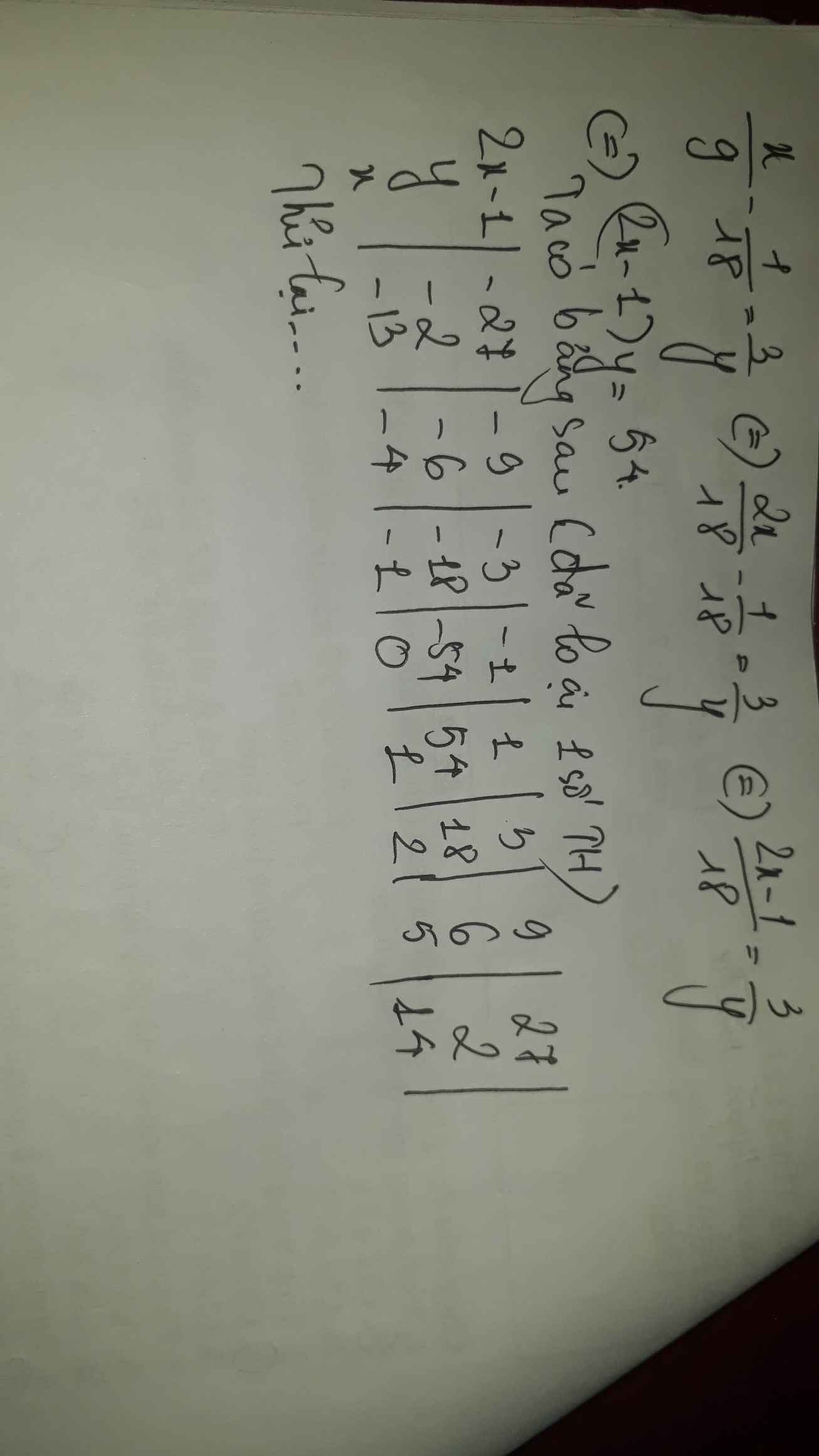Tìm x, y sao cho \(\dfrac{x}{9}-\dfrac{3}{y}=\dfrac{1}{18}\)

Những câu hỏi liên quan
Tìm x,y thuộc Z:
(x+1).(y+3)=6
(x-3).(y+1)=11
\(\dfrac{x}{9}\)-\(\dfrac{3}{y}\)=\(\dfrac{1}{18}\)
ai giải giúp mình với
mình đang cần gấp
Đúng 0
Bình luận (0)
Tìm x,y ∈ N biết
\(\dfrac{x}{9}\)=\(\dfrac{3}{y}\)+\(\dfrac{1}{18}\) Help me
\(\dfrac{x}{9}=\dfrac{3}{y}+\dfrac{1}{18}\left(y\ne0\right)\)
\(\Rightarrow\dfrac{2xy}{18y}=\dfrac{54}{18y}+\dfrac{y}{18y}\)
\(\Rightarrow2xy=54+y\)
\(\Rightarrow2xy-y=54\)
\(\Rightarrow xy-\dfrac{y}{2}=27\)
\(\Rightarrow y\left(x-\dfrac{1}{2}\right)=27\)
\(\Rightarrow\left(x-\dfrac{1}{2}\right);y\in\left\{1;3;9;27\right\}\)
\(\Rightarrow\left(x;\right)y\in\left\{\left(\dfrac{1}{2};27\right);\left(\dfrac{5}{2};9\right);\left(\dfrac{17}{2};3\right);\left(\dfrac{53}{2};1\right)\right\}\)
\(\Rightarrow\left(x;y\right)\in\varnothing\left(x;y\inℕ\right)\)
Đúng 3
Bình luận (0)
tìm x,y \(\dfrac{x}{9}-\dfrac{3}{y}=\dfrac{1}{18}\)
Giải chi tiết giúp mik vs ạ
\(\dfrac{x}{9}-\dfrac{3}{y}=\dfrac{1}{18}\left(ĐKXĐ:y\ne0\right)\)
\(\Rightarrow\dfrac{xy-27}{9y}=\dfrac{1}{18}\)
\(\Rightarrow18\left(xy-27\right)=9y\)
\(\Rightarrow2\left(xy-27\right)=y\)
\(\Rightarrow2xy-54=y\)
\(\Rightarrow2xy-y=54\Rightarrow y\left(2x-1\right)=54\)
\(\Rightarrow y=\dfrac{54}{2x-1}\)
- Suy ra 54 chia hết cho 2x - 1
\(\Rightarrow2x-1\inƯ\left(54\right)\)
\(\Rightarrow2x-1\in\left\{1;-1;2;-2;3;-3;9;-9;27;-27\right\}\)
Cho 2x - 1 bằng từng giá trị ở trên, ta tìm được :
\(x\in\left\{1;0;\dfrac{3}{2};-\dfrac{1}{2};2;-1;5;-4;14;-13\right\}\). Mà x không có giá trị ngoài tập số nguyên.
\(\Rightarrow x\in\left\{-13;-4;-1;0;1;2;5;14\right\}\)
Thay các giá trị x trên vừa tìm được vào y :
\(\Rightarrow y\in\left\{54;-54;18;-18;6;-6;2;-2\right\}\)
Vậy : Các số x và y thỏa mãn đề bài là : \(\left(x;y\right)\in\left\{\left(1;54\right),\left(0;-54\right),\left(2;18\right),\left(-1;-18\right),\left(5;6\right),\left(-4;-6\right),\left(14;2\right),\left(-13;-2\right)\right\}\)
Đúng 1
Bình luận (1)
Tìm các số tự nhiên x,y sao cho : \(\dfrac{x}{9}-\dfrac{3}{y}=\dfrac{1}{18}\)
\(\dfrac{x}{9}-\dfrac{3}{y}=\dfrac{1}{18}\)
\(\dfrac{x}{9}-\dfrac{1}{18}=\dfrac{3}{y}\)
\(\dfrac{2x}{18}-\dfrac{1}{18}=\dfrac{3}{y}\)
\(\dfrac{2x-1}{18}=\dfrac{3}{y}\)
\(\Rightarrow\)(2x-1).y=18.3=54
54 có các ước là: \(\pm1;\pm2;\pm3;\pm6;\pm9;\pm18;\pm27;\pm54\)
*\(\left\{{}\begin{matrix}2x-1=1\\y=54\end{matrix}\right.\Rightarrow\left\{{}\begin{matrix}2x=2\\y=54\end{matrix}\right.\Rightarrow\left\{{}\begin{matrix}x=1\\y=54\end{matrix}\right.\)
*\(\left\{{}\begin{matrix}2x-1=54\\y=1\end{matrix}\right.\Rightarrow\left\{{}\begin{matrix}2x=55\\y=1\end{matrix}\right.\)\(\notin\) N ( Loại)
*\(\left\{{}\begin{matrix}2x-1=2\\y=27\end{matrix}\right.\Rightarrow\left\{{}\begin{matrix}2x=3\\y=27\end{matrix}\right.\) \(\notin\) N ( Loại )
*\(\left\{{}\begin{matrix}2x-1=27\\y=2\end{matrix}\right.\Rightarrow\left\{{}\begin{matrix}2x=28\\y=2\end{matrix}\right.\Rightarrow\left\{{}\begin{matrix}x=14\\y=2\end{matrix}\right.\)
*\(\left\{{}\begin{matrix}2x-1=3\\y=18\end{matrix}\right.\Rightarrow\left\{{}\begin{matrix}2x=4\\y=18\end{matrix}\right.\Rightarrow\left\{{}\begin{matrix}x=2\\y=18\end{matrix}\right.\)
*\(\left\{{}\begin{matrix}2x-1=18\\y=3\end{matrix}\right.\Rightarrow\left\{{}\begin{matrix}2x=19\\y=3\end{matrix}\right.\)\(\notin\) N ( Loại )
*\(\left\{{}\begin{matrix}2x-1=6\\y=9\end{matrix}\right.\Rightarrow\left\{{}\begin{matrix}2x=7\\y=9\end{matrix}\right.\)\(\notin\) N ( Loại )
*\(\left\{{}\begin{matrix}2x-1=9\\y=6\end{matrix}\right.\Rightarrow\left\{{}\begin{matrix}2x=10\\y=6\end{matrix}\right.\Rightarrow\left\{{}\begin{matrix}x=5\\y=6\end{matrix}\right.\)
Vậy có các cặp (x,y) t/m đề bài là : (1,54) ; (14,2) ; (2,18) ; (5,6)
Đúng 0
Bình luận (1)
1. left(y+dfrac{1}{3}right)+left(y+dfrac{1}{9}right)+left(y+dfrac{1}{27}right)+left(y+dfrac{1}{81}right)dfrac{56}{81}
2. 18:dfrac{Xx0,4+0,32}{X}+514
3. dfrac{3xX}{2}dfrac{2}{5}+X+dfrac{1}{3}
4. X-dfrac{11}{15}dfrac{3+X}{5}
Đọc tiếp
1. \(\left(y+\dfrac{1}{3}\right)\)+\(\left(y+\dfrac{1}{9}\right)\)+\(\left(y+\dfrac{1}{27}\right)\)+\(\left(y+\dfrac{1}{81}\right)\)=\(\dfrac{56}{81}\)
2. 18:\(\dfrac{Xx0,4+0,32}{X}\)+5=14
3. \(\dfrac{3xX}{2}\)=\(\dfrac{2}{5}+\)X\(+\dfrac{1}{3}\)
4. X-\(\dfrac{11}{15}\)=\(\dfrac{3+X}{5}\)
Bài 1:
$(y+\frac{1}{3})+(y+\frac{1}{9})+(y+\frac{1}{27})+(y+\frac{1}{81})=\frac{56}{81}$
$(y+y+y+y)+(\frac{1}{3}+\frac{1}{9}+\frac{1}{27}+\frac{1}{81})=\frac{56}{81}$
$4\times y+\frac{40}{81}=\frac{56}{81}$
$4\times y=\frac{56}{81}-\frac{40}{81}=\frac{16}{81}$
$y=\frac{16}{81}:4=\frac{4}{81}$
Đúng 0
Bình luận (0)
Bài 2:
$18: \frac{x\times 0,4+0,32}{x}+5=14$
$18: \frac{x\times 0,4+0,32}{x}=14-5=9$
$\frac{x\times 0,4+0,32}{x}=18:9=2$
$x\times 0,4+0,32=2\times x$
$2\times x-x\times 0,4=0,32$
$x\times (2-0,4)=0,32$
$x\times 1,6=0,32$
$x=0,32:1,6=0,2$
Đúng 0
Bình luận (0)
Bài 3:
$\frac{3\times x}{2}=\frac{2}{5}+x+\frac{1}{3}$
$1,5\times x=x+\frac{11}{15}$
$1,5\times x-x=\frac{11}{15}$
$x\times (1,5-1)=\frac{11}{15}$
$x\times 0,5=\frac{11}{15}$
$x=\frac{11}{15}: 0,5=\frac{22}{15}$
Đúng 0
Bình luận (0)
Xem thêm câu trả lời
Tìm số nguyên x, y biết:
\(a,\dfrac{x}{5}=\dfrac{-18}{10}\) b, \(\dfrac{6}{x-1}=\)\(\dfrac{-3}{7}\) c, \(\dfrac{y-3}{12}\)=\(\dfrac{3}{y-3}\) d, \(\dfrac{x}{25}\)=\(\dfrac{-5}{x^2}\)
\(a,\dfrac{x}{5}=\dfrac{-18}{10}\\ \Rightarrow x=-\dfrac{18}{10}.5\\ \Rightarrow x=-9\\ b,\dfrac{6}{x-1}=\dfrac{-3}{7}\\ \Rightarrow6.7=-3\left(x-1\right)\\ \Rightarrow42=-3x+3\\ \Rightarrow42+3x-3=0\\ \Rightarrow3x+39=0\\ \Rightarrow3x=-39\\ \Rightarrow x=-13\\ c,\dfrac{y-3}{12}=\dfrac{3}{y-3}\\ \Rightarrow\left(y-3\right)^2=36\\ \Rightarrow\left[{}\begin{matrix}y-2=6\\y-2=-6\end{matrix}\right.\\ \Rightarrow\left[{}\begin{matrix}y=8\\y=-4\end{matrix}\right.\)
\(d,\dfrac{x}{25}=\dfrac{-5}{x^2}\\ \Rightarrow x^3=-125\\ \Rightarrow x^3=\left(-5\right)^3\\ \Rightarrow x=-5\)
Đúng 3
Bình luận (0)
Bài 1: Tìm x,y,z:a) dfrac{x}{y}dfrac{10}{9}; dfrac{y}{z}dfrac{3}{4}; x-y+z 78b)dfrac{x}{y}dfrac{9}{7};dfrac{y}{z}dfrac{7}{3}; x-y+z -15c)dfrac{x}{3}dfrac{y}{4}dfrac{z}{3}; x2 +y2+z2200
Đọc tiếp
Bài 1: Tìm x,y,z:
a) \(\dfrac{x}{y}\)=\(\dfrac{10}{9}\); \(\dfrac{y}{z}\)=\(\dfrac{3}{4}\); x-y+z =78
b)\(\dfrac{x}{y}=\dfrac{9}{7}\);\(\dfrac{y}{z}\)=\(\dfrac{7}{3}\); x-y+z =-15
c)\(\dfrac{x}{3}\)=\(\dfrac{y}{4}\)=\(\dfrac{z}{3}\); x2 +y2+z2=200
a) Ta có: \(\dfrac{x}{y}=\dfrac{10}{9}\Rightarrow\dfrac{x}{10}=\dfrac{y}{9}\)
\(\dfrac{y}{z}=\dfrac{3}{4}\Rightarrow\dfrac{y}{3}=\dfrac{z}{4}\Rightarrow\dfrac{y}{9}=\dfrac{z}{12}\)
\(\Rightarrow\dfrac{x}{10}=\dfrac{y}{9}=\dfrac{z}{12}=\dfrac{x-y+z}{10-9+12}=\dfrac{78}{13}=6\)
\(\Rightarrow\left\{{}\begin{matrix}x=6.10=60\\y=6.9=54\\z=6.12=72\end{matrix}\right.\)
b)Ta có: \(\dfrac{x}{y}=\dfrac{9}{7}\Rightarrow\dfrac{x}{9}=\dfrac{y}{7}\)
\(\dfrac{y}{z}=\dfrac{7}{3}\Rightarrow\dfrac{y}{7}=\dfrac{z}{3}\)
\(\Rightarrow\dfrac{x}{9}=\dfrac{y}{7}=\dfrac{z}{3}=\dfrac{x-y+z}{9-7+3}=-\dfrac{15}{5}=-3\)
\(\Rightarrow\left\{{}\begin{matrix}x=-3.9=-27\\y=-3.7=-21\\z=-3.3=-9\end{matrix}\right.\)
c) \(\dfrac{x}{3}=\dfrac{y}{4}=\dfrac{z}{3}\)
\(\Rightarrow\dfrac{x^2}{9}=\dfrac{y^2}{16}=\dfrac{z^2}{9}=\dfrac{x^2+y^2+z^2}{9+16+9}=\dfrac{200}{34}=\dfrac{100}{17}\)
\(\Rightarrow\left\{{}\begin{matrix}x^2=\dfrac{900}{17}\\y^2=\dfrac{1600}{17}\\z^2=\dfrac{900}{17}\end{matrix}\right.\)\(\Rightarrow\left\{{}\begin{matrix}x=\pm\dfrac{30\sqrt{17}}{17}\\y=\pm\dfrac{40\sqrt{17}}{17}\\z=\pm\dfrac{30\sqrt{17}}{17}\end{matrix}\right.\)
Vậy\(\left(x;y;z\right)\in\left\{\left(\dfrac{30\sqrt{17}}{17};\dfrac{40\sqrt{17}}{17};\dfrac{30\sqrt{17}}{17}\right),\left(-\dfrac{30\sqrt{17}}{17};-\dfrac{40\sqrt{17}}{17};-\dfrac{30\sqrt{17}}{17}\right)\right\}\)
Đúng 1
Bình luận (0)
Tìm x;y;z biết :
1) \(\dfrac{1+2y}{6}=\dfrac{3+4y}{5}=\dfrac{9+6y}{2x+1}\)
2) \(\dfrac{1+2y}{18}=\dfrac{1+4y}{28}=\dfrac{1+6y}{6x}\)
2) Áp dụng tính chất dãy tỉ số bằng nhau ta có:
\(\dfrac{1+2y}{18}=\dfrac{1+6y}{6x}=\dfrac{1+2y+1+6y}{18+6x}=\dfrac{2\left(1+4y\right)}{2\left(9+3x\right)}=\dfrac{1+4y}{9+3x}\)
⇒ \(\dfrac{1+4y}{9+3x}=\dfrac{1+4y}{28}\)
⇒\(9+3x=28\)
⇒\(3x=19\)
⇒\(x=\dfrac{19}{3}\)
bạn thay vào là tìm được y
Đúng 1
Bình luận (0)
\(\dfrac{x}{9} - \dfrac{1}{18} = \dfrac{3}{y}\)

























